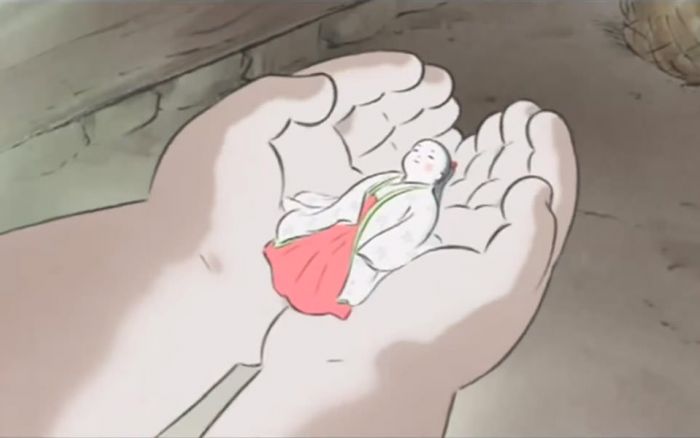
Isao Takahata may not be as well-known as his Studio Ghibli comrade, Hayao Miyazaki, but he is no less an animation master. The man behind such films as Grave of the Fireflies, Only Yesterday, and My Neighbors the Yamadas, Takahata’s films are a bit less fanciful and epic than Miyazaki’s, but are still beautiful, evocative works in their own right.
His most recent film, The Tale of Princess Kaguya, is based on the 10th century Japanese fairy tale The Tale of the Bamboo Cutter. The film has been nearly 8 years in the making, and was released into Japanese theatres earlier this month. From the reviews so far, it appears that the wait has been worth it.
Christopher O’Keeffe, “Takatata’s THE TALE OF PRINCESS KAGUYA (aka THE TALE OF THE BAMBOO CUTTER) Is A Beautifully Evocative Fairy Tale”:
The most immediate and striking element here is the beautiful animation which works wonderfully to evoke the idea of a fairytale, having the appearance of an ancient Japanese emakimono, a picture scroll used for telling stories. In relation to the studio’s other films the watercolor tones are most similar to Takahata’s previous work My Neighbors the Yamadas, although the films style is completely different to that modern family comedy. While shots of people in the fields or in the background of the city are accurate and lifelike simulating the working culture of the time, the main characters are brilliantly realized, some being highly stylized caricatures, some more realistic, all unique. The opening scenes with Kaguya as a baby capture so wonderfully a child’s early movements, her adopted parents are all warmth and smiles, her teacher is prim and proper, the suitors are arrogant and flawed and Kaguya’s handmaiden, despite her face being drawn with about three brush strokes, is hilarious. On the whole it’s breath-taking but further flashes of brilliance make it transcendent, including a stunning scene when the young princess flees from her home into the woods causing the delicate lines to turn a deeper black and solid shapes to fall away into a speeding blur of swirling color, capturing the fear and confusion of the moment.
Mark Schilling, “Ghibli’s Takahata returns triumphant after 14 years”:
His exploration, though, has little to do with plot, everything to do with his heroine’s emotional and spiritual journey — and the way it ends. Not to enter spoiler territory, but the climax is a haunting, wrenching evocation of mono no aware — or as it is literally translated, the pathos of things. The basis of Japanese aesthetics since time immemorial, mono no aware is hard to define, but “The Tale of Princess Kaguya” brilliantly illuminates it with images of life at its transient loveliest, of parting in its terrible finality.
There is a deep wisdom in this film, but a deep sadness too. If it is Takahata’s farewell, it’s one that will have a long echo, just like his 1,000-year-old source.
Richard Eisenbeis, “Studio Ghibli’s Newest is a Beautiful, Heart-Wrenching Film”:
All in all, The Tale of Princess Kaguya is a film that is just a joy to watch. By focusing on Kaguya as a person instead of an object, the film turns Japan’s oldest folktale into a story about normal people trying to find happiness. Add to that the most beautiful, unique animation in years and you have an instant classic. If you are looking for a fairytale that you can identify with on a personal level — or just want to see something breathtaking — The Tale of Princess Kaguya is right up your alley.
In other words, if you are going to watch only one Ghibli movie this year, make it this one.